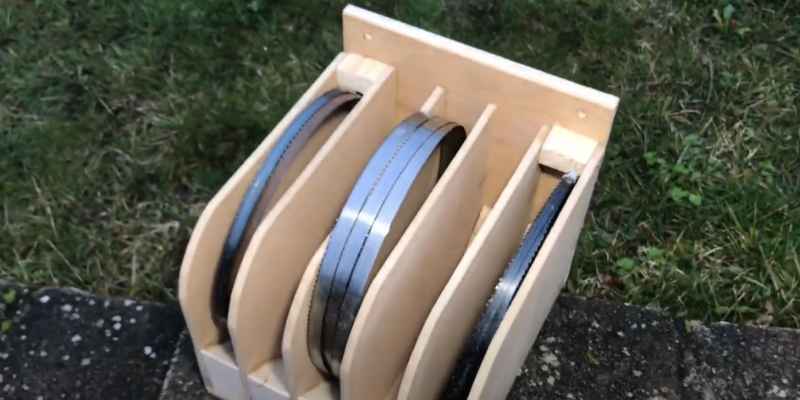Proper band saw blade storage is essential to prevent damage and maintain the blade’s performance.
Importance Of Proper Band Saw Blade Storage
Proper band saw blade storage is essential to maintain the quality and longevity of your blades. When blades are not stored correctly, they can easily get damaged and their lifespan significantly reduced. Taking the time to store your band saw blades properly can save you both time and money in the long run. In this article, we will discuss the importance of proper band saw blade storage and provide you with some practical tips to ensure your blades are well-maintained.
Preventing Damage
One of the key benefits of proper blade storage is preventing damage to your band saw blades. When blades are not stored correctly, they are more susceptible to rust, pitting, and damage from other objects in your workshop. This can result in decreased cutting performance, irregular cuts, and the need for more frequent blade replacements. To avoid these issues, follow these tips:
- Keep the blades clean and dry: Remove any dirt, debris, or sawdust from the blade before storing it. Use a clean cloth or brush to wipe away any residual particles. Moisture can lead to rust, so make sure the blade is completely dry before storing.
- Use blade protectors: Invest in blade protectors or covers to keep the blades safe from accidental bumps or scratches. These protective covers can help prevent damage during storage and transport.
- Store blades in a cool, dry place: Avoid storing blades in humid or damp areas, as this can accelerate rusting. Opt for a dedicated storage area or rack that is clean, well-ventilated, and away from direct sunlight.

Prolonging Blade Lifespan
Proper storage practices can significantly prolong the lifespan of your band saw blades. By taking care of your blades, you can maximize cutting performance and avoid premature replacements. Follow these tips to ensure your blades last longer:
- Store blades in a vertical position: Storing blades in a vertical position prevents excessive bending or warping, which can affect their cutting performance. Use a blade storage rack that allows you to hang the blades vertically and keeps them organized.
- Avoid over-tensioning: It’s important not to over-tension your blades when storing them. Over-tensioning can cause stress to the blades and result in weakened performance over time. Follow the manufacturer’s recommendations on tensioning, and release any excessive tension before storing them.
- Label your blades: Remember the specifics of each blade by labeling them accordingly. Include information such as the blade type, TPI (teeth per inch), and the date of purchase. This will help you track the usage and lifespan of each blade, improving your overall maintenance strategy.
By following these simple but effective tips, you can ensure that your band saw blades remain in optimal condition throughout their lifespan. Properly stored blades will provide you with consistent cutting performance, minimized downtime, and substantial cost savings.
Common Mistakes In Band Saw Blade Storage
Exposure To Moisture
Incorrect storage of band saw blades leaves them prone to exposure to moisture. Moisture can lead to rust and deterioration of the blade, affecting its performance and longevity. When blades are left in damp conditions, this can result in the formation of rust, rendering the blade ineffective and potentially causing damage to the material being cut.
Incorrect Temperature Settings
Storing band saw blades in areas with incorrect temperature settings can be detrimental. Extreme temperatures can cause the metal to expand and contract, leading to stress on the blade and potential warping. This can compromise the blade’s structural integrity and result in inaccurate cuts.
Optimal Conditions For Band Saw Blade Storage
Band saw blades are essential tools for woodworking, metalworking, and other fabrication tasks. Proper storage of band saw blades is crucial to maintaining their performance and longevity. Optimal conditions for band saw blade storage include controlling temperature and humidity levels, and considering the duration of storage.
Temperature And Humidity Levels
Proper temperature and humidity levels are critical for preserving the integrity of band saw blades. It is recommended to store band saw blades in a controlled environment with a temperature range between 40°F to 70°F and humidity levels around 40% to 50%.
Storage Duration
When storing band saw blades, keep in mind the duration of storage. Blades should be used within a reasonable timeframe to ensure their quality and sharpness. It is best to rotate the use of blades if stored for an extended period.
Smart Solutions For Band Saw Blade Storage
Use Of Blade Protectors
Blade protectors are indispensable for storing band saw blades. These protective covers prevent the blades from being damaged, keeping them in optimal condition for future use. Designed to fit snugly over the blades, these protectors act as a shield against dust, moisture, and other potential hazards, prolonging their lifespan.
When storing your band saw blades, it’s crucial to clean them thoroughly and ensure they are completely dry. Next, secure each blade in a blade protector, ensuring it is the correct size for a snug fit. Properly covered, your band saw blades will be shielded from environmental factors that can shorten their shelf life.
Organized Storage Systems
An organized storage system is essential for efficient band saw blade management. Storing band saw blades can be a challenge due to their size and shape, but with strategic organizing, you can maximize space and ensure quick access when needed.
- Consider investing in a storage cabinet specifically designed for band saw blades. These cabinets typically feature slots or compartments that allow you to neatly store blades of various sizes.
- If you prefer a more DIY approach, mount a pegboard on the wall and attach hooks or clips to hang your band saw blades. Arrange them by size or tooth configuration for easy identification.
- Another option is to utilize labeled plastic bins or containers, ensuring each blade is individually wrapped and placed in its designated storage space. This method is particularly useful for users with a large blade collection.
Whichever storage system you choose, it’s important to handle the blades with care during retrieval and return. Mishandling can lead to accidental damage, resulting in the need for premature blade replacement.
Implementing A Blade Maintenance Schedule
Create a blade maintenance schedule to ensure proper band saw blade storage, extending its lifespan and performance. Regular inspection and cleaning help prevent corrosion and damage, keeping the blade sharp for efficient cutting operations. Proper storage practices are essential in preserving the blade’s quality and longevity.
Regular inspections, cleaning, and lubrication of band saw blades are critical for maintaining their efficiency and longevity. Implementing a blade maintenance schedule ensures that your blades remain in top condition, leading to smoother cuts and prolonged durability.
Regular Inspection
Regularly inspect band saw blades for signs of wear, such as dulling, cracks, or missing teeth. Look for any residue buildup or irregularities that may affect the cutting performance. Replace blades that show significant wear to prevent damage to your equipment.
Cleaning And Lubrication
Cleaning your band saw blades regularly helps to remove debris and buildup that can impact cutting quality. Use a brush or cloth to wipe down the blades, ensuring they are free from dirt and residue. Apply a thin layer of lubricant to maintain smooth operation during cutting.
By following a blade maintenance schedule that includes regular inspection, cleaning, and lubrication, you can prolong the life of your band saw blades and ensure optimal cutting performance.

Innovative Storage Ideas For Band Saw Blades
Vertical Wall Racks
Utilize vertical wall racks to efficiently store band saw blades in a space-saving manner.
- Easily access different blade sizes by organizing them vertically.
- Maximize storage capacity while keeping blades visible and within reach.
- Securely mount racks to walls for safe storage and quick blade identification.
Mobile Blade Storage Carts
Enhance flexibility with mobile blade storage carts that allow easy transport and organization.
- Quickly move blade inventory to different workstations for convenient access.
- Ensure safety by securely locking blades in place during transportation.
- Optimize workflow efficiency with a mobile storage solution tailored for band saw blades.
Case Studies: Successful Blade Storage Practices
Industrial Applications
Industrial environments require efficient and organized blade storage solutions to ensure smooth operations. Many successful case studies have demonstrated the importance of implementing proper blade storage practices in large-scale manufacturing facilities. By utilizing designated storage areas equipped with specialized racks and labeling systems, industrial settings can minimize downtime and maximize productivity.
Small Workshop Settings
In smaller workshop settings, effective blade storage is equally vital for maintaining a safe and functional work environment. Case studies have shown that implementing simple yet systematic storage methods, such as wall-mounted racks and compact storage bins, can significantly enhance the overall workflow. By keeping blades organized and easily accessible, small workshops can optimize their space and streamline their cutting processes.
Future Trends In Band Saw Blade Storage
With the advancement in technology, the future of band saw blade storage is evolving rapidly. From automation and tracking technologies to environmentally friendly solutions, the way we store and manage band saw blades is undergoing a significant transformation.
Automation And Tracking Technologies
In the near future, automation will revolutionize band saw blade storage. Automated systems will eliminate the need for manual handling, reducing the risk of accidents and injuries. These systems will efficiently handle the loading and unloading of band saw blades, ensuring they are stored in the most optimal conditions.
One of the most notable automation trends is the use of robotic arms equipped with sensors and cameras. These arms can accurately track the location of each band saw blade and retrieve them when needed. This technology minimizes the time required to find and retrieve a specific blade, enhancing the overall efficiency of operations.
Another exciting development is the integration of RFID tags in band saw blades. These tags allow for real-time tracking of blades throughout the storage facility. By using RFID scanners, operators can quickly locate and identify the exact position of each blade, streamlining inventory management and reducing downtime.
Environmentally Friendly Solutions
As businesses become increasingly aware of their environmental impact, sustainable and eco-friendly solutions are gaining traction in band saw blade storage.
One such trend is the use of biodegradable packaging materials. Instead of traditional plastic wraps or containers, manufacturers are opting for biodegradable alternatives. These materials are not only more environmentally friendly but also help to protect the blades from corrosion.
Moreover, the adoption of energy-efficient storage systems is on the rise. These systems utilize advanced insulation materials and climate control mechanisms to maintain optimal temperature and humidity levels. By minimizing energy consumption, businesses can reduce their carbon footprint while ensuring the longevity of their band saw blades.
Frequently Asked Questions Of Band Saw Blade Storage
How Should I Store My Band Saw Blades?
Band saw blades should be stored in a dry, cool environment, hung vertically to prevent bending or warping. It’s best to use a blade organizer or make a DIY storage rack to keep them organized and protected.
What Is The Best Way To Protect Band Saw Blades From Rust?
To prevent rust, clean the blades with a dry cloth after each use, apply a light coat of oil, and store them in a dry environment. Consider using silica gel packs or a dehumidifier to control moisture in the storage area.
How Often Should I Replace Band Saw Blades?
The frequency of blade replacement depends on usage and maintenance. Inspect the blade for wear, dullness, or damage regularly, and replace it if you notice any issues affecting cutting performance or safety.
Can I Store Different Types Of Band Saw Blades Together?
It’s not recommended to store different types of band saw blades together as mixing them can cause damage or dulling. Keep them separated and labeled to avoid confusion and maintain their respective qualities.
Conclusion
By implementing proper band saw blade storage techniques, you can extend the lifespan of your blades and ensure optimal performance. Remember to clean and properly label each blade, store them in a designated area away from moisture and extreme temperatures, and use blade covers or cases.
Taking these simple steps will not only save you money on replacements but also enhance the efficiency and effectiveness of your band saw. Keep your blades organized and protected, and enjoy smooth and precise cuts every time.


